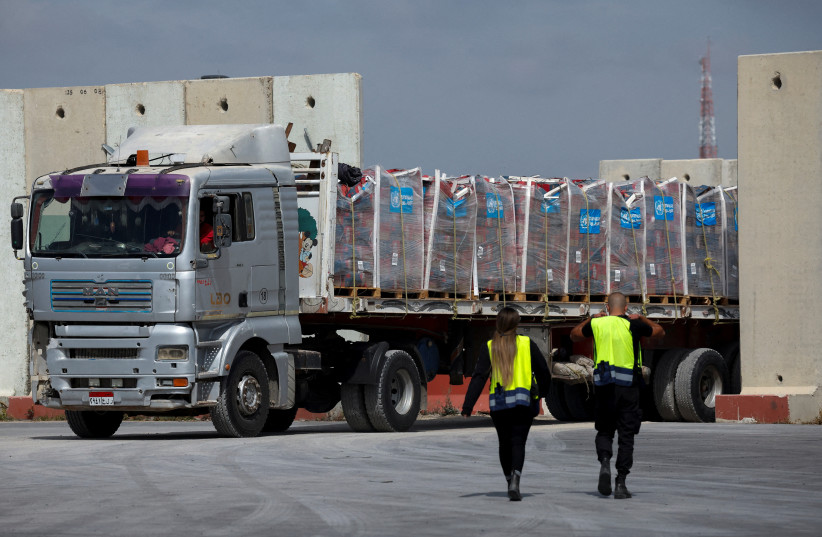Several recent reports indicated that while the US had delivered around 569 metric tons of aid to Gaza, it was not clear if it actually reached the people who needed it. This has raised questions about the US-built pier that took months to plan and build.
The pier is only one of many ways aid is reaching Gaza, however, and all of them, including the crossings, are problematic. The reason for this is the nature of how humanitarian organizations have worked in Gaza for many years.
First, let’s look at a few facts. Aid reaches Gaza through the US-built pier. It also reaches Gaza through the Kerem Shalom crossing in southern Gaza. It also reaches Gaza via the Erez crossing and the Erez West crossing. There is also the Gate 96 entrance to Gaza. Gate 96 is the entrance to the Netzarim corridor south of Gaza City, an area controlled by the IDF.
The US-built floating pier is also affixed to an area controlled by the IDF and the Netzarim corridor. Aid entering via Erez or Erez West, however, enters areas controlled by Hamas. Aid entering via Kerem Shalom now enters an area controlled by the IDF, which is advancing in Rafah. There is also the Rafah crossing in southern Gaza that goes to Egypt. Egypt closed the crossing when the IDF took over the Gaza side on May 7.
Israel’s unit for the Coordination of Government Activities in the Territories (COGAT), which coordinates humanitarian aid entering Gaza, on Tuesday said 451 trucks had crossed into Gaza over the past 24 hours. They crossed via Erez West and Kerem Shalom. Seventy trucks entered via Erez West, and the rest came through Kerem Shalom, COGAT said.

Preventing Hamas from getting a hold on aid
This sounds a lot like mafia-style protection. It’s clear that historically, the NGOs operating in Gaza coordinated with Hamas. They claimed they worked with Hamas “police.” But Hamas police are the same as Hamas.
The problem today in Gaza is that seven months into the war, it is hard to keep the aid from getting into Hamas’s hands. This is due to the patchwork of control in Gaza and because Hamas returns mafia-like to every place it can.
Is Hamas stealing the aid and selling it? It’s not clear how much is stolen or sold, and it doesn’t appear to be in the interests of the UN or NGOs involved in the aid distribution to say what is happening with the aid. Clearly, they have an interest in saying the aid is reaching the people in need.
No organization wants to admit it handed over some aid to terrorists or mafia gunmen. But the organizations also know if they condemn Hamas, then they could be in danger. This is why comparing the situation to a mafia or cartel environment is useful.
The challenge for Israel is that it is opening the crossings to Gaza and trying to facilitate multiple routes of aid. This means the aid comes via Ashdod and also from Jordan. But it is in the interest of Hamas to make aid delivery difficult because it knows that the more there are fears of “famine,” the more there is pressure on Israel to stop the war.
This means everyone’s interests in Gaza are not aligned. Israel’s interest is to get aid to the crossings, but it can’t monitor where it all goes. In theory, aid could be tracked, as modern technology could accomplish that. But it doesn’t appear to be a goal of the war effort to track the aid. Also, any attempt to do so would lead the NGOs to claim Israel had endangered them somehow.
On the other side of the coin, the NGOs have an interest in claiming their aid is being delivered, rather than diverted and sold. Some of them also have an interest in perpetuating the crisis by claiming there could be famine, thereby keeping their organizations in business. This means their interests are not aligned with getting as much aid as possible into the right hands.
Hamas has an agenda as well. It wants to divert the aid, possibly steal it or sell it, or even create a false impression of crisis.
This means at every point of the aid triangle there are conflicting interests. Israel wants the aid to get to the crossing, but it doesn’t do much after it gets there. The NGOs want to claim the aid is delivered, but they don’t want to admit if it is stolen, and they have an interest in continuing the crisis. Hamas has an interest in stealing or selling the aid and perpetuating the crisis.
Getting aid right in Gaza will require finding a way to keep Hamas from stealing it and making sure the NGOs are transparent about where it is going. In addition, it likely will mean having Israel take a greater interest in what happens after the aid crosses into Gaza. Therefore, reforming the triangle of aid delivery is important.
